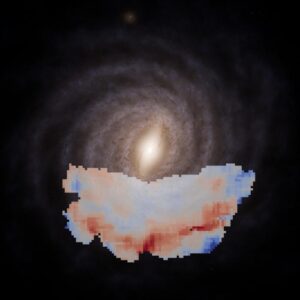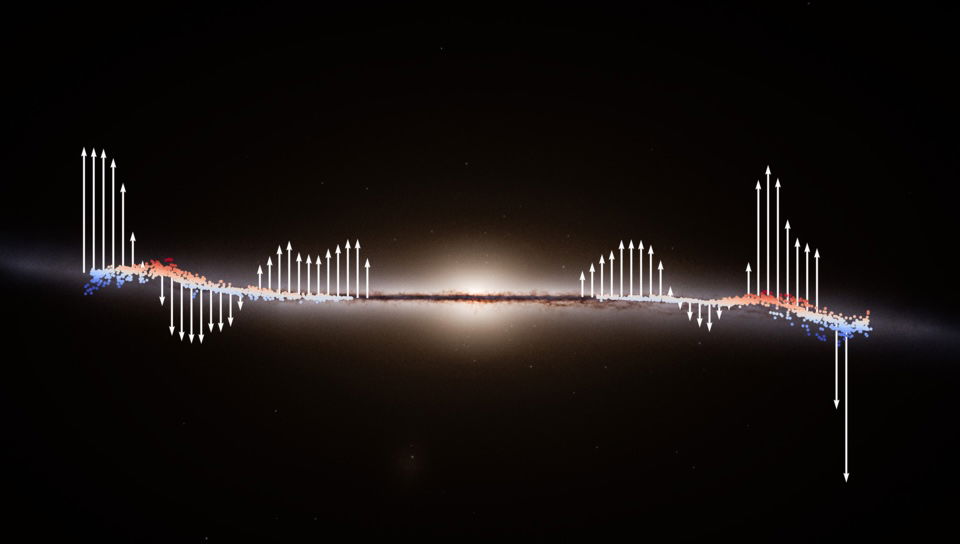The source of our Milky Way galaxy’s strange wobble has finally been revealed after the European Space Agency’s Gaia space telescope revealed an enormous wave rippling out from the galactic center.
Over the last century, astronomers have gradually pieced together the structure and dynamics of our galaxy—first its spin, then the warping of its disc, its top-like wobble, and now, its vast rippling wave.
The new discovery was reported in a paper published in Astronomy and Astrophysics.
Gaia Observes the Cosmos
Gaia is one of today’s most important tools for collecting precise data on stellar motion and structure across the Milky Way. Unlike the James Webb Space Telescope, which focuses on more distant targets, Gaia’s mission is to create an accurate 3D map of our home galaxy. It does this by tracking the movement of stars toward Earth, away from it, and across its field of view.
Researchers estimate the wave spans at least 30,000 to 65,000 light-years from the galactic center, undulating like ripples in a pond. The Milky Way itself extends just over 100,000 light-years, though without a sharply defined edge, allowing the wave to reach stars along the galaxy’s diffuse outer regions.
“What makes this even more compelling is our ability, thanks to Gaia, to also measure the motions of stars within the galactic disc,” says lead author Eloisa Poggio, an astronomer at the Istituto Nazionale di Astrofisica (INAF) in Italy. “The intriguing part is not only the visual appearance of the wave structure in 3D space, but also its wave-like behaviour when we analyse the motions of the stars within it.”
 The above graphic displays the ESA Gaia data over a top view of the Milky Way, with stars pushed above the galactic disc by the wave in red and those pushed below in blue. Credit: ESA/Gaia/DPAC, S. Payne-Wardenaar, E. Poggio et al (2025)
The above graphic displays the ESA Gaia data over a top view of the Milky Way, with stars pushed above the galactic disc by the wave in red and those pushed below in blue. Credit: ESA/Gaia/DPAC, S. Payne-Wardenaar, E. Poggio et al (2025)
A Wave Appears
The discovery emerged as researchers analyzed the movements of young giant and Cepheid stars. These stars proved ideal reference points, as their variable brightness follows steady, predictable rhythms, making them easy to track with Gaia. Their positions revealed a vertical shifting pattern consistent with a vast wave moving across the galactic disc.
The effect resembles a stadium wave, with each star caught in a different stage of motion as the ripple passes. Unlike in a sports arena, however, the galactic wave moves on timescales so vast that Gaia’s observations capture the turbulence as if frozen in place.
“This observed behaviour is consistent with what we would expect from a wave,” Poggio explained.
What’s Behind the Disturbance?
The cause of the disturbance remains uncertain. One leading hypothesis is that a dwarf galaxy collided with the Milky Way in the distant past, generating large-scale turbulence. Another possibility is a connection to the Radcliffe Wave, a much smaller ripple structure that begins approximately 500 light-years from the Sun and extends more than 9,000 light-years.
“However, the Radcliffe Wave is a much smaller filament, and located in a different portion of the galaxy’s disc compared to the wave studied in our work (much closer to the Sun than the great wave). The two waves may or may not be related. That’s why we would like to do more research,” Poggio said.
The discovery adds to more than a century of work unraveling the Milky Way’s structure. And researchers may not have long to wait for new insights: Gaia’s fourth major data release is scheduled for December 2026, promising an even deeper trove of stellar information.
“The upcoming fourth data release from Gaia will include even better positions and motions for Milky Way stars, including variable stars like Cepheids,” says Johannes Sahlmann, ESA’s Gaia Project Scientist.
“This will help scientists to make even better maps,” he added, “and thereby advance our understanding of these characteristic features in our home galaxy.”
The paper, “The Great Wave Evidence of a Large-scale Vertical Corrugation Propagating Outwards in the Galactic Disc,” appeared in Astronomy and Astrophysics on July 14, 2025.
Ryan Whalen covers science and technology for The Debrief. He holds an MA in History and a Master of Library and Information Science with a certificate in Data Science. He can be contacted at ryan@thedebrief.org, and follow him on Twitter @mdntwvlf.


